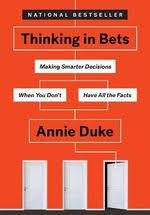Annie Duke’s main premise in ‘Thinking in Bets’is that all decisions are bets. What jobs we choose, where we live, what partners we share our lives with – these are all bets we have made. A bet is “a choice made by thinking about what will probably happen”, a decision with an uncertain future. A bet involves beliefs, probability, choice, and risk. We rely on our set of beliefs to identify what the potential outcomes of a situation could be. We make a determination about the probability of each of those outcomes. With that information, we make a bet. As we watch the bet unfold, we use that information from the outcome to shape our beliefs for future bets. Duke posits to be skilled at betting, the bettor needs to understand how much of the outcome is attributed to luck and how much is attributed to skill.
To understand how to be a more skilled decision maker, Duke spends the beginning of the book teaching the reader fallacies in human thought processes. Some of these fallacies and applications include:
Resulting: Thinking the outcome of a decision determines the quality of the decision made. Selling a stock off right before market rallies does not mean the decision was bad depending on the information available.
Hindsight bias: Knowing the outcome to a decision makes that outcome feel like it was inevitable, and all other possible outcomes are forgotten. Looking at the market after selling stock for example, would in hindsight bias make the seller feel that there is no possibility that the stock could have maintained or gained value.
Self-serving bias: Taking credit for the good outcomes and blaming the bad outcomes to luck while watching others and attributing luck for their good outcomes while thinking bad outcomes were inevitable. We blame bad luck for the market rally after our stocks was sold but if the stock had plummeted after it was sold, we attribute the sale to our investment acumen.
Important for our community comprised of decision makers, the remainder of ‘Thinking in Bets’provides tangible ways to beat these fallacies and increase the quality of bets made.
Scenario planning: Map out the situation (visually if possible), listing out all outcomes and the qualifiable value of the outcomes to the organisation. Determine probabilities of the outcomes. Calculate expected values to ensure that decisions are made considering not just the best valued outcome to the organisation, but the most valuable considering the likelihood of occurrence.
Back casting: Imagining the group has reached their goal, work backwards to identify the strategies, tactics, and actions that are needed to get to this end state. This helps to identify if goals are too lofty for the group or set conditions to increase probability of required events to happen.
Pre-mortems: Complimenting back casting, imagining the group has failed to reach their goal, identify strategies, tactics, and actions that led to failure. Incorporating negative visualisations techniques are actually found to make it more likely to achieve goals.
These are just a few of the numerous take-aways I had when I put down ‘Thinking in Bets’. As a comprehensive yet quick read filled with numerous examples, Duke has changed the way I view my problem sets. I find myself challenging the confidence levels in my beliefs, trying to learn from other’s outcomes to develop my beliefs, and make my own uncertainty clear when communicating decision processes. The book has inspired me to make more thoughtful decisions. I am conscious that better quality decisions increase our chances of good outcomes. The existence of luck will ensure good outcomes are not guaranteed!
Darby Nelson is a Marine Corps Supply Officer stationed in Okinawa, Japan. She has a strong interest in the quest to be both smart and strong. She also has a fascination with the Australian Army. You can follow her on twitter @darbyanelson

